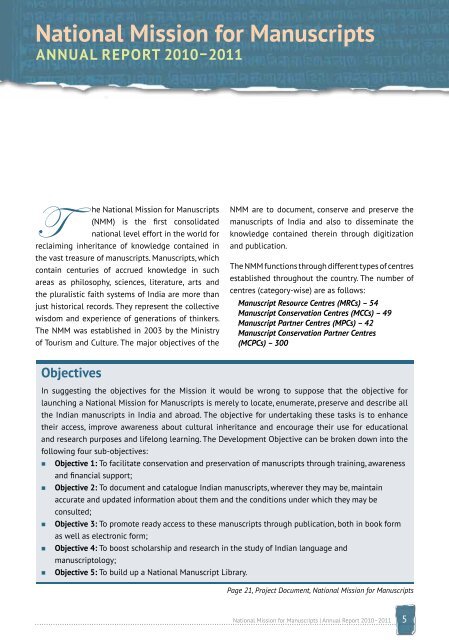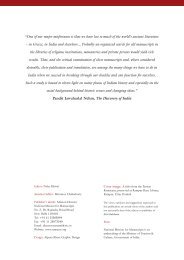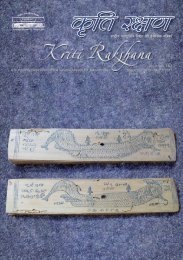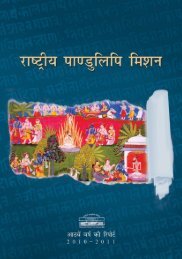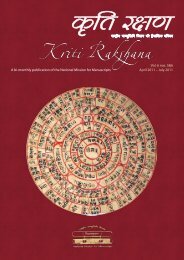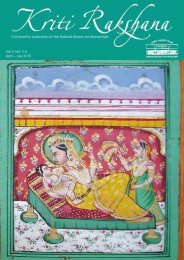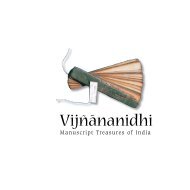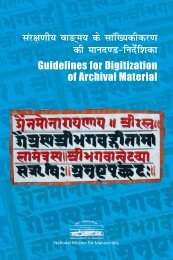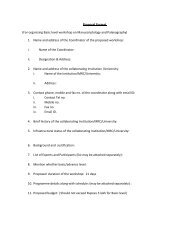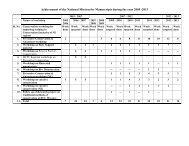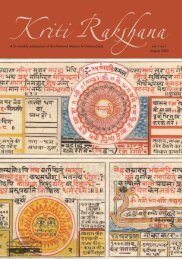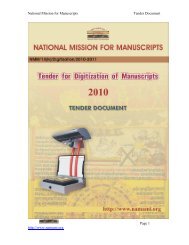which sustained the ecological balance <strong>for</strong> hundreds andhundreds of years but which was erroneously labeledas blind faith by the modernist and which has led tosevere ecological degradation in the country. The reasonI mention all these things is to emphasize the need ofconnecting with the Indian knowledge system whichhad developed as a result of rigorous intellectual activityand growth and which has also connected well with thesociety. It had made the society an active participant inthe application of knowledge thus ensuring a stable andprosperous existence.We need to tap into this vast resource available to allwho would care to look into it and make use of whatis available <strong>for</strong> furthering intellectual growth as wellas social prosperity and peace. This knowledge systemis an integral part of Indian environment, culturally aswell as physically and it contains the seeds of solutionsto our problems. The NMM has during the year 2010-2011 tried to connect the past with the present in aneffective way.Emphasis was laid on bringing to light the hiddenliterature available in different disciplines throughseminars. The following seminars were held during theperiod under review:i) Manuscript resources in North East Region:Problems of conservation and dissemination, atDharamanagar, Tripuraii) Traditional Medicine system of India, at Universityof Kerala, Thiruvananthapuramiii) International conference on Persian and Arabic<strong>Manuscripts</strong>: <strong>National</strong> Heritage of CompositeCulture, at University of Delhiiv) <strong>National</strong> seminar on Buddhist Sanskrit Textsand their Conservation at Nagarjuna BuddhistFoundation, Gorakhpurv) <strong>Manuscripts</strong> on Poetics in Southern Peninsulaat A.P. Government Oriental Manuscript Library,Hyderabadvi) <strong>Manuscripts</strong> as alternative Textual Traditions atCentral University of Gujarat, Gujaratvii) Mathematical <strong>Manuscripts</strong> in India at Kund KundJnanapitha, IndoreThis programme will be continued in future also, tocover those areas which could not be covered duringthis financial year.To involve and equip young scholars in manuscriptstudies courses on manuscriptology and palaeographywere held in different parts of the country. It washeartening to see enthusiastic response from all sectionsof the academic world. Advanced level Manuscriptologycourses were used as a plat<strong>for</strong>m to train young scholarsin critically editing manuscripts. Experts were carefullychosen and given a group of five to six young scholars.They gave them on hands training in critically editingmanuscripts. At the end of these advanced level courseswe had several manuscripts edited and ready <strong>for</strong>publication which are now being published by NMM.Response to our preventive conservation and curativeconservation courses was also very encouraging andthis ef<strong>for</strong>t has ensured better care of manuscripts inrepositories and personal holdings.Three Expert Committees were set up to shortlistmanuscripts <strong>for</strong> publication: first <strong>for</strong> Persian Arabic andUrdu, another <strong>for</strong> Dravidian languages and third <strong>for</strong>Indo-Aryan languages. The experts gave us full supportas a result of which several manuscripts were selectedand allocated to scholars <strong>for</strong> editing, annotating andtranslation. We hope, due to these ef<strong>for</strong>ts, we will beable to publish several manuscripts next year.Work in the field of digitization has gone on full steamand we have completed the second phase during which70,000 manuscripts (approx. 44 lakhs folios) weredigitized. This would help us in establishing a <strong>National</strong>Digital <strong>Manuscripts</strong> Library in the near future. In ourenthusiasm of initiating new programmes we did notignore the regular programmes that are part of NMMcalendar i.e. Tattvabodha lecture. Instead of holding allthe lectures at Delhi it was decided to hold them allover India and out of 24 lectures 20 were allocatedto different centres in almost all the states. Publicresponse to these lectures proved the desirability ofthis decision. Collection of these lectures will in duecourse be published as has been done previously.We also paid special attention to the north-eastern regionas a result of which we were able to actively involvethe states of Manipur, Mizoram, Tripura and Assam in ouractivities. The richness of this tangible heritage in thesestates has to be seen to be believed. We hope to expandour activities in the other states in the coming year.During all these activities the <strong>Mission</strong> did not <strong>for</strong>getits task of creating a database. During the year underreview we achieved the target of in<strong>for</strong>mation on morethan 32 lakh manuscripts in our database, of which,approximately 20 lakhs have been uploaded on theweb. The details of our activities and achievements arein the hands of discerning readers to see and evaluate.It is my pleasant duty to thank the Ministry of Culture<strong>for</strong> its support, the staff at NMM <strong>for</strong> their dedicatedwork and partners all over India <strong>for</strong> their commitment,enthusiasm and support <strong>for</strong> <strong>Mission</strong>’s venture whichhas made the year 2011 a memorable year.Prof. Dipti S. TripathiDirector, <strong>National</strong> <strong>Mission</strong> <strong>for</strong> <strong>Manuscripts</strong><strong>National</strong> <strong>Mission</strong> <strong>for</strong> <strong>Manuscripts</strong> | Annual Report 2010–2011
<strong>National</strong> <strong>Mission</strong> <strong>for</strong> <strong>Manuscripts</strong>Annual Report 2010–2011The <strong>National</strong> <strong>Mission</strong> <strong>for</strong> <strong>Manuscripts</strong>(NMM) is the first consolidatednational level ef<strong>for</strong>t in the world <strong>for</strong>reclaiming inheritance of knowledge contained inthe vast treasure of manuscripts. <strong>Manuscripts</strong>, whichcontain centuries of accrued knowledge in suchareas as philosophy, sciences, literature, arts andthe pluralistic faith systems of India are more thanjust historical records. They represent the collectivewisdom and experience of generations of thinkers.The NMM was established in 2003 by the Ministryof Tourism and Culture. The major objectives of theNMM are to document, conserve and preserve themanuscripts of India and also to disseminate theknowledge contained therein through digitizationand publication.The NMM functions through different types of centresestablished throughout the country. The number ofcentres (category-wise) are as follows:Manuscript Resource Centres (MRCs) – 54Manuscript Conservation Centres (MCCs) – 49Manuscript Partner Centres (MPCs) – 42Manuscript Conservation Partner Centres(MCPCs) – 300ObjectivesIn suggesting the objectives <strong>for</strong> the <strong>Mission</strong> it would be wrong to suppose that the objective <strong>for</strong>launching a <strong>National</strong> <strong>Mission</strong> <strong>for</strong> <strong>Manuscripts</strong> is merely to locate, enumerate, preserve and describe allthe Indian manuscripts in India and abroad. The objective <strong>for</strong> undertaking these tasks is to enhancetheir access, improve awareness about cultural inheritance and encourage their use <strong>for</strong> educationaland research purposes and lifelong learning. The Development Objective can be broken down into thefollowing four sub-objectives:• Objective 1: To facilitate conservation and preservation of manuscripts through training, awarenessand financial support;• Objective 2: To document and catalogue Indian manuscripts, wherever they may be, maintainaccurate and updated in<strong>for</strong>mation about them and the conditions under which they may beconsulted;• Objective 3: To promote ready access to these manuscripts through publication, both in book <strong>for</strong>mas well as electronic <strong>for</strong>m;• Objective 4: To boost scholarship and research in the study of Indian language andmanuscriptology;• Objective 5: To build up a <strong>National</strong> Manuscript Library.Page 21, Project Document, <strong>National</strong> <strong>Mission</strong> <strong>for</strong> <strong>Manuscripts</strong><strong>National</strong> <strong>Mission</strong> <strong>for</strong> <strong>Manuscripts</strong> | Annual Report 2010–2011
- Page 4 and 5: National Mission for ManuscriptsMan
- Page 8 and 9: Programmes and ActivitiesI. Documen
- Page 10 and 11: A view of the Manuscript Exhibition
- Page 12 and 13: • To involve local people and stu
- Page 14 and 15: DocumentationWith an estimated of t
- Page 16 and 17: Participants at Manuscript Day Prog
- Page 18 and 19: 18 Kavikulaguru Kalidasa University
- Page 21 and 22: Preventive conservation workshop he
- Page 24 and 25: Dr. Usha Suresh in interaction with
- Page 26 and 27: Sl.NoMCC13. Dev Kumar JainArrah, Bi
- Page 28 and 29: A folio from Arsharamayana, RORI, J
- Page 30 and 31: Shrimadbhagvad manuscript, M.R. Sha
- Page 32 and 33: This is an accepted method of verif
- Page 34 and 35: Participants at the Basic Level Wor
- Page 36 and 37: OutreachWith a view to spreadingawa
- Page 38 and 39: Sr. no. Collaborating Institution/V
- Page 40 and 41: Manuscriptology & PalaeographyThe m
- Page 42 and 43: Participants busy in editing during
- Page 44 and 45: Tattvabodha Volume-IIEdited by: Kal
- Page 46 and 47: The first of the Krtibodha series w
- Page 48 and 49: SHABAD GURUIllustrated Catalogue of
- Page 50 and 51: ConservationDr. Kirti SrivastavaCoo
- Page 52 and 53: Functional Network of theNational M
- Page 54 and 55: Oriental Research InstituteSri Venk
- Page 56 and 57:
INTACH ICIOrissa Art Conservation C
- Page 58 and 59:
Our PartnersManuscript Resource Cen
- Page 60 and 61:
Director, National Mission for Manu
- Page 62 and 63:
Department of Manuscriptology,Kanna
- Page 64:
Oriental Research Institute, Mysore
- Page 67 and 68:
history and culture of South India.
- Page 69 and 70:
An illustration from Palakapya Gaja
- Page 71 and 72:
Address:Dr. Buddhadev SharmaSecreta
- Page 73 and 74:
course in Pali, Tibetan, Sanskrit,
- Page 75 and 76:
Dharmashastra, Karmakanda, Ayurveda
- Page 77 and 78:
Anandashram SansthaThe Anandashram
- Page 79 and 80:
Participants at National Seminar on
- Page 81 and 82:
Address:Dr. Shyamsingh RajpurohitR.
- Page 83 and 84:
Our PartnersManuscript Conservation
- Page 85 and 86:
Address:Dr. P. GoswamiCoordinatorVr
- Page 87 and 88:
Government Museum, ChennaiThe Gover
- Page 89 and 90:
the Muslim period in Oriental studi
- Page 91 and 92:
Krishna Kanta Handiqui Library,Guwa
- Page 93 and 94:
Bhandarkar Oriental ResearchInstitu
- Page 95 and 96:
Archaic Manipuri and few manuscript
- Page 97 and 98:
Kriti Rakshna, by - monthly publica
- Page 99:
Future PlansContinued training prog


